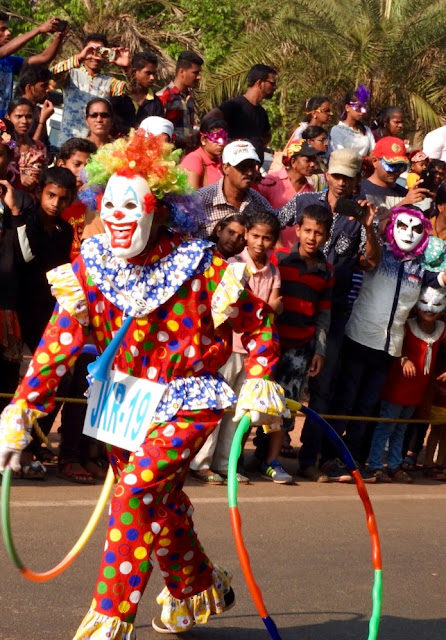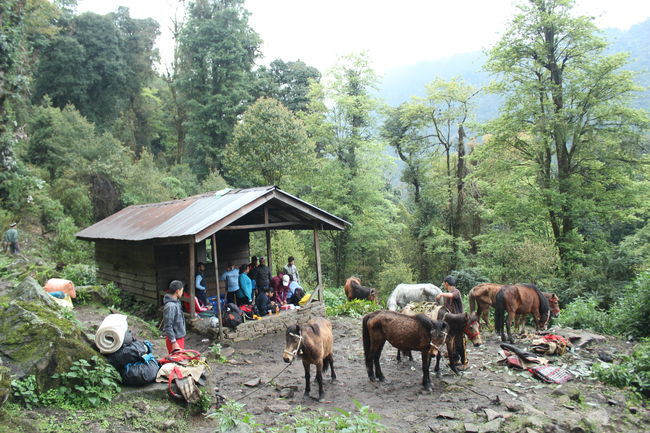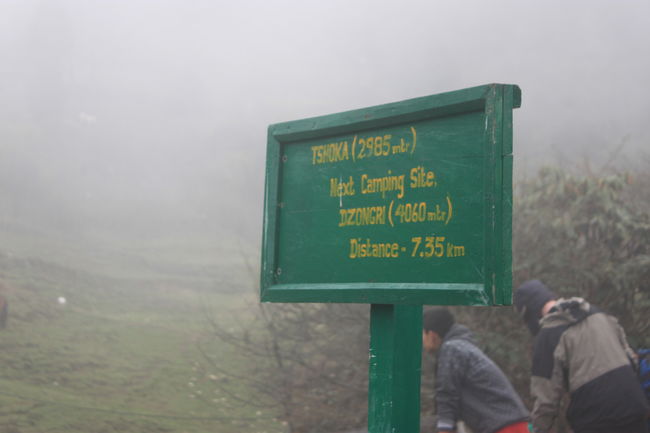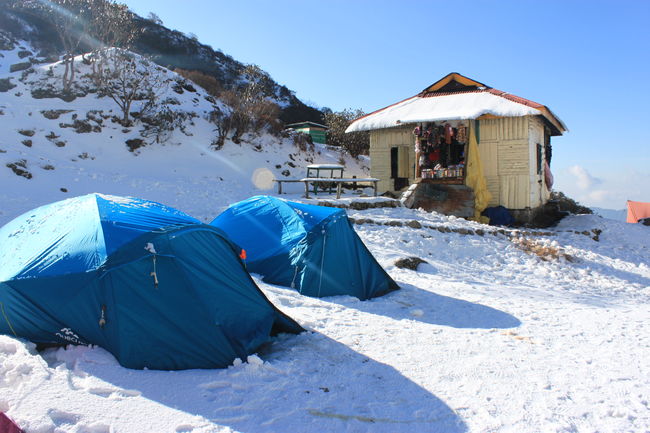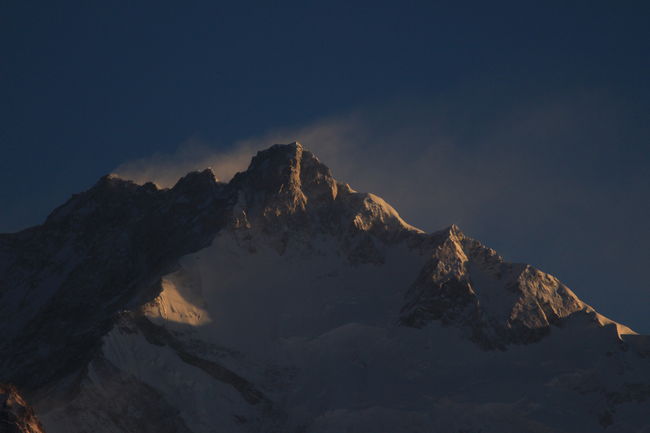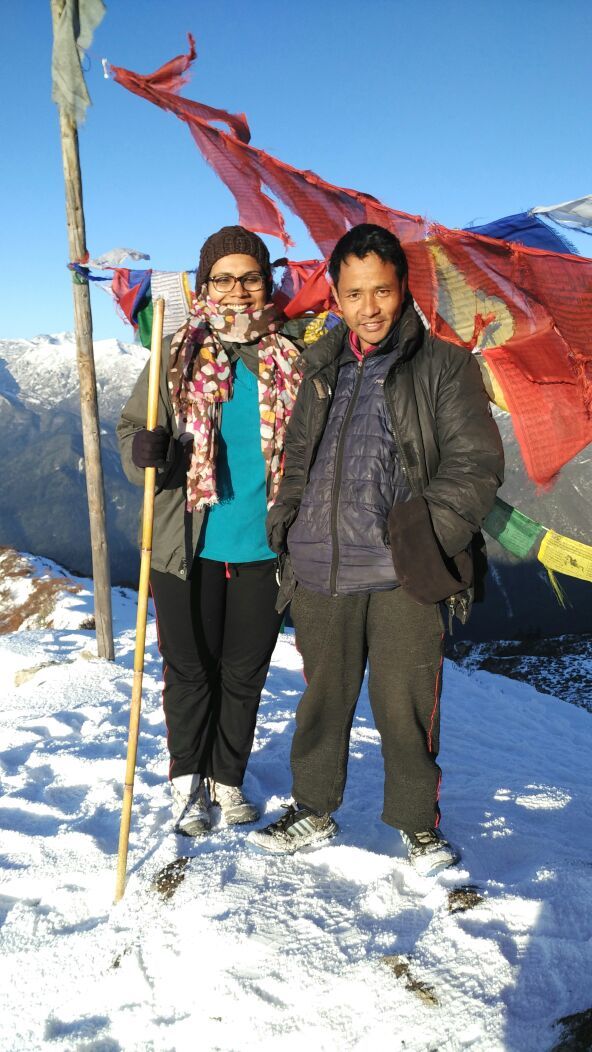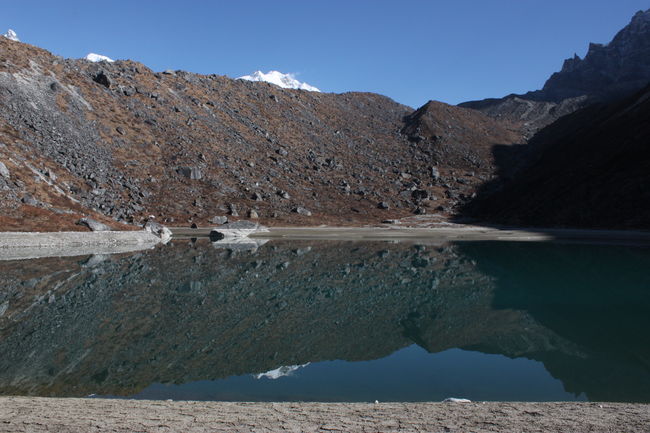Every day you come across so many travel quotes that keep knocking your News Feed on the social networking sites, and probably, you just read them, smile, and scroll down, thinking that someday you’ll get a chance to respond to the call of the travel bug.
I, too, do this often – I mean the reading scrolling down part, but with that, I respond to the calls as well, because I believe that ‘the chance’ never comes unless you bring it in.
It was quite a few months back, when I was randomly talking to my friend, and she told me that this trek was on the cards. I have never trekked before, I had no clue how it is like to walk for hours, and neither did I clearly know the details – I just randomly agreed to the plan!
After all the anticipation, it was finally the day when I was to step out for the first trek of my life – little did I know then that it would make such an impact on me. Away from the cacophony of the urban life, being amidst nature, accompanied by the Himalayas, was indeed one of the best gifts life ever bestowed me with.
For me, the journey began from Delhi to Bagdogra, and then, an hour’s drive to Siliguri. I met all the other folks (read: friends) at NJP, from where we started for Yuksom, West Sikkim.
We were a team of 11 people, who tagged a fancy name – The Alpinists!
From NJP to Yuksom, it takes nearly 7 hours – and Yuksom is one of the most beautiful villages in the lap of the mighty mountains. There’s nothing much to explore, but still the place has a charm of its own. Before we set out for the 10 days of rigorous walk, we had a chilled out evening at Yuksom, visiting the Monastery and binged on delicious momos!
The Trek Route:
Day 1: Yuksom to Sachen – Walking through the Kanchenjunga National Park is an experience in itself. The lush greenery, the freshness in the air, the clouds playing around and kissing the peaks, the sunshine on and off – everything seemed way beyond perfect. It was raining on that day, and since it was my first time, there were difficulties – but then, when you’re there, you can easily keep the difficulties aside, and aim to move ahead.
The walk from Yuksom to Sachen was for 6 hours (considering the fact that my speed was extremely slow!). The campsite at Sachen was in the middle of the jungles, and the eerie silence didn’t fail to give me goosebumps.
Day 2: Sachen to Tshoka, via Bakhim – The second day was way more difficult than the first day, and our guide, Aakash, had already told us about it. The trail was at a slope of nearly 70-degrees, and the temperature was dropping rapidly. It was almost 8 hours walk that day.
There were rhododendrons and magnolia blooming throughout the trail – it seemed that nature was dressed up, just to welcome us. Sometimes, I was lost in thoughts, wondering how beautiful nature can be… I felt like someone has painted the landscape, and I was walking through it.
I’ve never seen so much of colors in my life, and I felt that even the best painter might get amazed to see such variety of shades…
Tshoka has a proper campsite, with toilets, and kitchen, and a hut. There’s a monastery as well, and a little lake, adding more beauty to the place.
From the campsite, you’ll get a glimpse of Mt.Pandim and Mt.Kabru (well, yes! These are among the higher range peaks which our geography books never taught us about!).
Day 3: Tshoka to Dzongri, via Phedang: The trail here was properly done with wooden logs, making the walk a bit smoother till Phedang. From there, it starts getting steep, and we experienced heavy snowfall. It’s a 7-8 hours walk, though we took more time since it’s much difficult to walk on the snow.
By the time we reached Dzongri, it was absolutely covered with snow. To me, it seemed like a dream - white everywhere, with little colorful tents in a row.
The night sky at Dzongri was the best that I’ve ever seen in my life… It seemed as if I can touch it, and get a star for myself!
Everyone was extremely tired and so, we all went inside the tents to rest. Only till there was the snowstorm, which blew away our tent! – Oh! What an experience it was – scary and thrilling at the same time.
Day 5: Climb to Dzongri Peak; Rest day at Dzongri – The fifth day began at around 3.30am, when we started out trek towards the Dzongri peak, to soak ourselves in the first sunshine.
The temperature had dropped much below the freezing point, still, the enthusiasm to see the Kanchenjunga kept us going.
All my mates were quite ahead of me, and slowly the distance between me and them increased, as I realized that my body was giving up. It was getting difficult for me to breathe, as my nose was frozen, and all I could do was breathe through my mouth – but my guide constantly kept telling me not to breathe through the mouth.
To be thankful to the Supreme for our life is probably that last thing that comes to our mind – we give priorities to everything in the world, and much importance to this mortal body – but often fail to realize how precious each breath is! It’s then, that I realized how a person might be feeling on the death bed, trying to gasp another breath.
I paused to breathe after every 20 steps and kept sipping the chilled water. And undoubtedly, Gurung, my guide, was the constant source of motivation.
We were still at a distance from the peak when the first rays of dawn crossed the horizon. Gurung told me about the peaks in a row – Mt. Tinchenkhan, Mt. Kabru, North Kabru, South Kabru, Mt.Pandim, and the gorgeous Kanchenjunga – I saw the peaks turning golden one after another, as the sun rays glided down the snowy steeps! What I saw is actually difficult to be put in words – one has to see it with his own eyes, to believe in the power of Nature.
Reaching the Dzongri peak (4171 m) felt like an achievement in itself. There I stood, amazed, surrounded by the snow-clad peaks on all sides – it took me some time to believe my eyes, and somewhere deep inside, I felt proud of myself, for the very fact that I did something I never imagined I could do!
After coming back to the Dzongri campsite, we had a day to relax and enjoy the snow. The campsite looked like something straight out of the pages of some fantasy novel – with snow all around, and our yaks and horses roaming here and there. In a line, stood our colorful tents, adding vibrancy to the entire landscape.
It was a much-needed break since our muscles also craved for some relaxation. Sitting on the snow, soaking the warm sun rays and binging on Maggi and yak meat was truly delightful. Well, yes – one should definitely try the local food while on the go, and missing out this delicious yak meat cooked in typical Sikkimese style is totally undesirable!
We tried the local liquor as well, called thongba, which is made from fermented millets, and served in a bamboo mug. The most amazing thing about thongba is that it never gets over! Yes, you read it right – keep adding lukewarm water to your mug, and enjoy your drink till you feel satisfied enough!
Day 6: Dzongri to Kokhchurang - The walk was comparatively easier, as most of the trail is through a valley, and the rest of it was downhill. After much of snow at Dzongri, we got to see some green meadows, and the clouds played hide n’ seek with us, veiling and unveiling the mountains, which gave us constant company.
As we started walking downhill, I realized that it wasn’t as easy as I assumed it to be, because the snow had started melting, making the trail extremely slippery, and dangerous. The trail ran through the forest, that was a bit dense, and my friends were anticipating that a snow leopard might peek out from behind a tree – well, that didn’t really happen!
From quite a distance, I could hear the rhythm of a flowing river, but couldn’t see any. It was only when we stepped out of the forest, and reached the Kokhchurang campsite, that I got to see Prekchu closely for the first time.
Kokhchurang campsite was exactly like those European country sides that I’ve read about in books and imagined all my life – a little cottage next to a forest, with a river on one side and a wooden bridge, a patch of grassland where yaks and horses grazed, and the mountains at a distance, standing like a boundary wall to this little picture-perfect settlement.
The evening at Kokhchurang was one the best times I’ve had in the entire trek – sitting by Prekchu, listening to its constant rhythm, observing the flow and the distant mountains, with my feet dipped in the freezing cold water – one of those moments which made me feel how I miss all these in the otherwise monotonous life.
Day 7: Kokhchurang to Lamuney via Thangsing – This was comparatively an easier walk, mostly through the jungle trails, and valley – and there're not much of hurdles. The best part of this trail is that you’ll be accompanied by Prekchu River throughout, and can gaze at Mt.Pandim and Mt.Tinchenkhan (if the clouds don’t cover them up)!
The narrow streams that were flowing into Prekchu crisscrossed our way every now and then, and although they had wooden bridges, I chose to cross the streams without using the bridges – it’s a bit of a risk, but totally worth taking (just make sure you don’t wet your shoes much!).
The forest trail had rocks covered with soft moss, and icicles hanging from them – these were the corners where the sun rays failed to reach. As the forest trail ends, and you are about to reach Thangsing, there’s a patch of grassland – a somewhat mystical place – which had the fragrance of wet grass soaked in the dew drops, infused with the smell of wet earth absorbing the mild sun rays – and as I sat there with my friend, it felt like time has stopped.
A few minutes’ rest, and we started walking again – we met a few others who were coming back that day, after doing Goechala – and they were all telling us about how their experience was.
We reached Lamuney by the afternoon – which was our last camp site. The tents were put right next to the river, and we could clearly see the mountains on the other side.
The day ended by 7 in the evening, and everyone had an extreme adrenaline rush, as our guide instructed us that we have to start our journey for Goechala at 2am!
Day 8: Lamuney to Goechala, and back to Thangsing - The temperature was well below freezing point when started for our ultimate destination – it was dark, with the stars shining brightly on us. Because of the chilly wind, it was quite difficult to breathe – however, the excitement kept us going. In the darkness, we crossed the Samiti Lake, and by the time I reached the Goechala viewpoint one, it was 6.30am. A topsy-turvy path led to the point, from where I saw Kanchenjunga, standing right there in front of me – pristine, glittery and more gorgeous than one can ever imagine!
The 7days’ hardships felt worthy after that one glimpse – and I felt the satisfaction and happiness of my being. My guide was so happy that I did it, for he was a constant source of courage when I almost gave up on the way.
We stayed there for around 15-20 mins, and started our walk back towards the camp.
To pause by the Samiti Lake was a must – and I wondered why I never knew about this place earlier. We hear so much about Pangong in Ladakh, may be because Bollywood has popularized the place, but Samiti Lake was no less than that. The crystal clear blue water, with a thin sheet of ice, reflected the mountains that surrounded it. Me and my guide sat there and had our breakfast, enjoying the eerie silence, which was broken at times by the call of the Himalayan Monals.
We reached the Lamuney camp site at around 9.30 am, and a few of my friends were already back. I was wondering that those who were making it to the second viewpoint would be witnessing a more picturesque view.
Everyone returned at around 1pm, and they narrated how dangerous and beautiful it was beyond the first viewpoint. I was glad that they could make it, for not many can reach up to that level.
After lunch, we set out for Thangsing, where we were halting for that night. We managed to get a room in the trekker's hut there.
Day 9: Thangsing to Tshoka, via Kokhchurang and Phedang - Returning has always a string of sorrow attached to it, and it seemed that even Nature was bidding a sad goodbye. As I walked back, the same trails looked a bit different - the grassland where I sat, had lost its fragrance - the icicles had melted - sun rays successfully seeped in, soaking the dewdrops and making the moss lose its lustre.
Even Prekchu sounded different - I felt that the sound of the flowing river when I climbed uphill, was more joyful than the one i listened to while coming downhill - I wondered if Prekchu would miss me the way I would do.
The walk from Kokhchurang to Phedang is entirely through the forest, where you'll come across several waterfalls, and we filled our bottles and drank the sweet fresh Himalayan water - bliss! I walked slower than I usually did, for I wanted to spend more time there, somehow the thought of coming back to the city haunted me - I wished I could stay there longer.
By the time we reached Tshoka, it was evening, and we had quite a long day. The guides gave us a farewell treat that day - with yak meat, and chicken, and cake! Such a bunch of adorable people they were.
Day 10: Tshoka to Yuksom, via Sachen - There was a mixed emotion - the paradox of life - the joy of returning home, and the sorrow of leaving Nature behind.
I walked alone that day, as everyone else were way ahead of me - I, as usual, took more time, to absorb all that I could, and made lame excuses to delay. My guide was curious to know whether I would ever come back for another trek there or not, and was eager to know how my otherwise usual life would be, once I head back home. I was replying to him, quite unconsciously, as I wanted to avoid those thoughts!
After reaching Yuksom, the first thing that I did was taking a bath - it was after 9 days that I got to take a bath!
And we decided to celebrate our achievement, that evening! Good food and alcohol was all that we needed, after the 10 days of Maggi and boiled eggs!
The next morning, I took a cab from Yuksom to Siliguri, and then To Bagdogra, as I had my flight to catch. All my friends stayed back, since they had their train in the evening.
The journey added a lot to my life - it's one of the most amazing chapters that I would never get bored of revisiting. It made me realize that life is what happens to you when you least expect it. I met some amazing people, who added some vibrant colors to my story. And i saw Nature - at its best!
To everyone out there, reading this - break the shackles of your monotonous life, have the courage to set out of the comfort zone. For once, breathe - and feel the importance of your breath. I can bet that you won't regret.
Happy traveling!
Photo Courtesy: Rijuman Datta, Kausik Pal.
The Trek Album:















